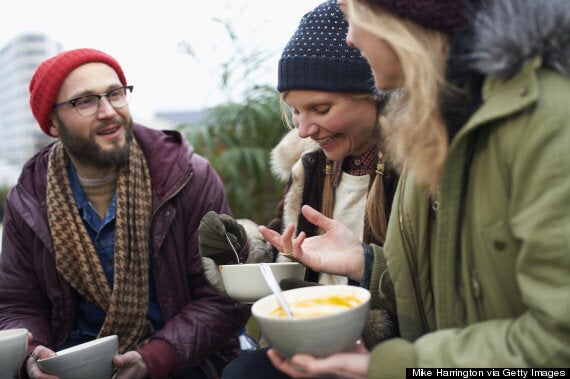
As if the post-Christmas period wasn't bleak enough, now there's a cold snap to add insult to injury.
But apart from being wholly unpleasant and nipping at our finger, ears, feet and noses... what does the cold snap actually do to us psychologically and physically?
HuffPost UK Lifestyle spoke to three experts - a consultant dermatologist, a nutritionist and a psychotherapist to find out what to look out for and how to prepare for it.
One of the biggest questions we get asked is why we tend to eat more when the weather gets colder.
"The body has an inbuilt barometer that monitors temperature and alters metabolism accordingly," says The Food Doctor nutritionist Alice Mackintosh. "so that it speeds up if we are cold to generate heat and slows it down to cool us. The mere process of shivering expends large amounts of energy which is one of the reasons we are often hungrier when it’s colder and could go without a large meal when it’s warmer."
While the cold isn't a carte blanche excuse to ladle on the cheese and bury your head in a mountain of potatoes, you should make sure you're getting good sleep and eating regularly. "If you are tired or haven’t eaten for a few hours and the body is lacking in energy, it is common to notice not being able to tolerate the cold as well as you would if you had just had a warming stew," Alice explains. "It is clear therefore why we gravitate towards warming foods in the winter."
SEE ALSO: How To Do Comfort Food The Healthy Way
Hot meals certainly help, but there are natural ways of encouraging heat in the body. "There are certain foods that help encourage warmth in the body and these tend to be things that get circulation going and can even get us sweating a little. Spices are the front runners with ginger, chilli, turmeric and garlic being excellent candidates. Putting ground nutmeg, cinnamon and cloves into porridge in the morning can give it an warming kick on an icy morning, and having a spicy curry for lunch or supper can warm the cockles quite nicely."

Comfort - or the perception of comfort- isn't just about food, though. "When we feel physically cold, we crave warmth and comfort - physically and emotionally," says psychotherapist Karin Sieger.
"We turn to our partners, families or friends, watch more good-time and romantic films, eat and drink more. Perhaps we can borrow from the Danish art of hygge (pronounced 'hooga), which roughly translates to coziness, and means creating a nice, warm atmosphere and sharing the good things in life with people you enjoy. Even if we are alone, putting more emphasis on a comfortable surrounding at home can help lift our spirits, and it needn't cost much."
Conversely, even though you may want to spend all your time indoors, indulging in that all the time is not the best idea.
"Depression and fatigue are higher during the winter months," she adds, "when there is less natural sunlight. Our bodies produce less Vitamin D, which is needed for proper immune function, and serotonin which affects our mood, sleep and appetite is low. Having an extra brisk walk during day light hours can help. Especially during a cold snap, with more sunlight, crisper air and less greyness and damp being outdoors can be uplifting."
When you are outdoors however, you may want to take preventative measures to protect any exposed skin.
Dr Nemesha Desai, consultant dermatologist at London Bridge Hospital, says: "As the weather gets colder, the skin becomes drier and more susceptible to irritants. Many of us experience tightness of the skin, stinging and irritation. Those with a tendency to dry skin may develop visible patches of dryness, scaling and even redness. Younger and older skin is more susceptible."
Story continues below the slideshow:
The reasons behind this, says Dr Desai, is because the humidity in the air drops with the temperature. "When exposed to drier air, water from the upper layers of the skin evaporates, leading to drying and cracking of the skin surface. The normal skin barrier is disrupted. Dry cracked skin is more permeable and vulnerable to attack by irritants such as soaps and solvents. Start your winter skin regime as early as you can."
DR DESAI'S TOP TIPS FOR WINTER SKIN
1. Keep re-hydrating the skin
- Start replacing moisture loss by switching to a richer regular moisturiser (e.g. creams, instead of lotions) and use moisturising washes or oils in the bath.
- Timing is key. The skin is most hydrated immediately after washing. The easiest and quickest way to seal in moisture is to apply a moisturiser within minutes of getting out of the bath or shower.
2. Avoid dehydrating the skin
- Turn the central heating down a notch. Central heating dries the air, lowering humidity in your home and dries the skin further.
- Take shorter showers or baths. Long hot baths also increase water loss from the skin surface.
3. Avoid irritants
- Your skin will be more susceptible to irritants in winter. Switch to soap free shower gels and soap free cleanser facial cleansers.